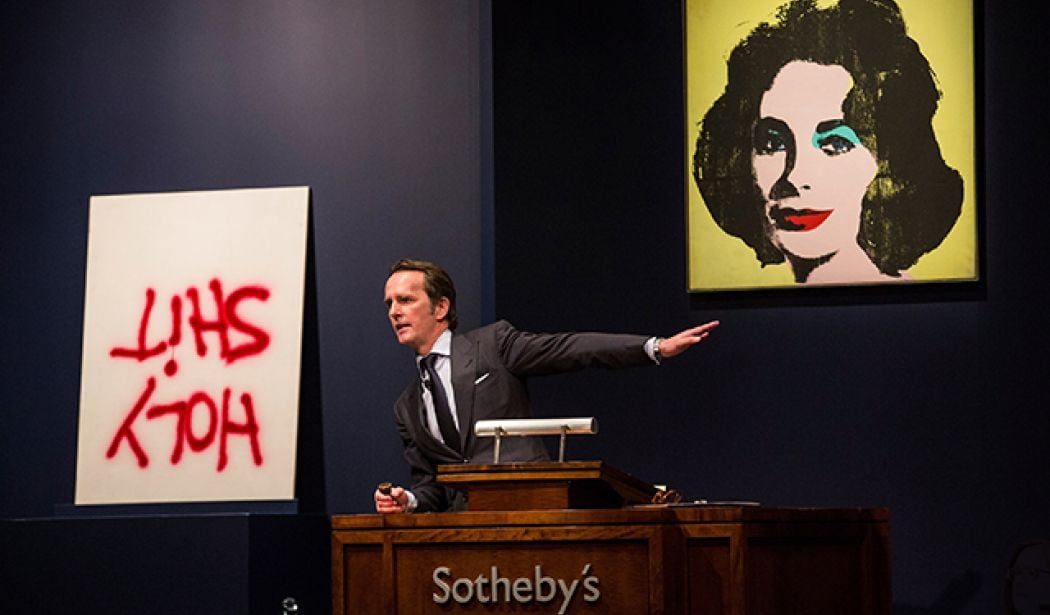Auctions
We Asked Collectors The 5 Scariest Things About Bidding on Art at Auction
The stakes are high when mishaps can cost millions.

The stakes are high when mishaps can cost millions.

Eileen Kinsella


Rarely is the intersection of art and money more potent than at the major auctions that take place each year at Christie’s, Sotheby’s, and Phillips.
Millionaire and billionaire buyers—both in the room and on the phones—are laser-focused on the trophies they are chasing. But with so much on the line, auction houses take no chances when it comes to fielding bids. They stock their salerooms with designated bid-spotters in case an overwhelmed auctioneer misses a raised paddle somewhere off in the back corner of a packed room.
So what could go wrong?
Plenty, judging from some of the mishaps we’ve observed firsthand or heard about through the grapevine over the years. They range from bad cellphone service and dropped calls, to missed bids, secret bidding signals that were too obscure to be understood, and in one recent case, a fainting spell.
Communication Breakdowns
Take, for instance, the time that an auction house specialist was phone bidding for a client on a multimillion-dollar work at a major evening sale and the collector’s wife suddenly jumped on the line. She yelped, “What is he doing?! Is this too expensive?” To which the specialist replied in a raised voice: “No, and it’s fantastic! He loves it, I love it, he always wanted it. Let him have it!”
The client underbid, but did not get the work.
The same specialist also handled a delicate situation where a gentleman who did not want his friend to know he planned to compete for the same work accepted his proposal for a secret bidding plan, whereby each time he touched his eyeglasses he indicated another bid.
The plan fell apart, and the secret bidder was outed when having ceased bidding, he forgot about his elaborate ruse and propped his glasses up on his nose, which in turn prompted the specialist to place another bid on his behalf.
Realizing what he had done, he cried out to the specialist by name to stop bidding. “His friend turned to him and at once got what was going on… I don’t know what ever happened to that friendship,” the specialist told artnet News.
Bidding Wars Gone Bad
On the evening of May 13, 2009, at Christie’s in New York, Greek shipping magnate Gregory Callimanopulos was thrilled when the hammer came down on a Sam Francis painting, titled, Grey (1954) that he had successfully bid $3 million on via Christie’s specialist April Jacobs.
Callimanopulos was dismayed when seconds later, the auctioneer re-opened the bidding because a paddle had gone up—namely that of the agent bidding for mega collector Eli Broad—who eventually won the work with a bid of $3.2 million (the price realized was $3.6 million). Callimanopulos was so furious at having lost the work that he filed suit against Christie’s, and later, Broad.
Though the suit was eventually thrown out by a judge, perhaps most interesting were the transcripts of the recorded phone call.
According to court documents in the case, Callimanopulos had immediately objected to the re-opened bidding.
He told Jacobs: “Tell him it’s me and I’m not accepting it.”
“There’s nothing I can do,’ Jacobs replied. ‘Do you want to do $3.2 million? They’re all looking at me.”
“Tell him Gregory Callimanopulos does not accept that,” the irate collector replied.
‘F*** him,’ Callimanopulos said when Broad’s assistant placed the final winning bid for the work.
Perhaps the biggest victim of the debacle was Jacobs, who left Christie’s shortly thereafter and “relocated to Texas with her family,” according to Christie’s, in response to questions from Bloomberg reporter, and current artnet News contributor, Philip Boroff.
It probably didn’t help that Calllimanopulos’s suit included an email from Jacobs sent the day after the sale: ”From my vantage point i did not see a paddle go up before the hammer went down. In my opinion we were the final bidder, and the piece sold to us for $3M.”
Psychological Warfare
One collector told us: “No one, and I mean no one, wants to go up against the Qataris.” If you’re after a Bacon, a Freud, a Hirst, or other blue-chip modern and contemporary artists, you’re probably out of luck.
And speaking of psych-outs, we heard one story about a bidder in a heated phone battle for a painting that eventually sold for over $80 million, who switched phone lines and bid through another specialist so that it appeared a new party had entered the fray at around $75 million. (A clever way to tire out an opponent, for sure, but we could not confirm whether this story actually occurred.)
But what we have witnessed, arguably with increasing frequency at some contemporary auctions, are bid leapers—those who choose to ratchet up the price on a painting by $4 million, when all the other competitors are sticking to more standard $250,000 and $500,000 level increments in their quest for a work.
Unsecured Works
That was the sound of a Gustave Courbet painting tumbling off the rotating turntable at one late ’90s Christie’s auction.The frame cracked, but the painting was reportedly not harmed.
Perhaps not surprisingly, however, the painting failed to sell.
Hilarious Hiccups
It should be noted that such auction mishaps are nothing new, though nowadays the stakes are considerably, and undeniably, higher.
For instance, Los Angeles collector Norton Simon was notorious for creating complicated bidding schemes that worked against him on more than one occasion.
To name just two that we confirmed: in one case he sent his wife, actress Jennifer Jones, to the saleroom to help prop up bidding—and scare away potential competitors—on a piece he desperately wanted, only to end up, unbeknownst to him, in a bidding war with her.
Eventually the specialist on the phone with him, who perhaps was familiar with Simon’s unorthodox bidding strategies, alerted him to the situation.
In another instance, documented in Sara Campbell’s biography on Simon, the LA collector arranged a plan so ludicrous for bidding on a Rembrandt that it seemed destined to fail.
According to notes made by the auctioneer at the time: “When Mr. Simon is sitting down he is bidding. If he bids openly when sitting down he is also bidding. When he stands up he has stopped bidding. If he then sits down again he is not bidding until he raises his finger. Having raised his finger he is continuing to bid until he stand up again.”
Not only was such a plan predictably impossible to execute, Simon lost any hope of anonymity as a competitor for the work when he leapt to his feet in the saleroom to protest the sale of the work to another bidder.